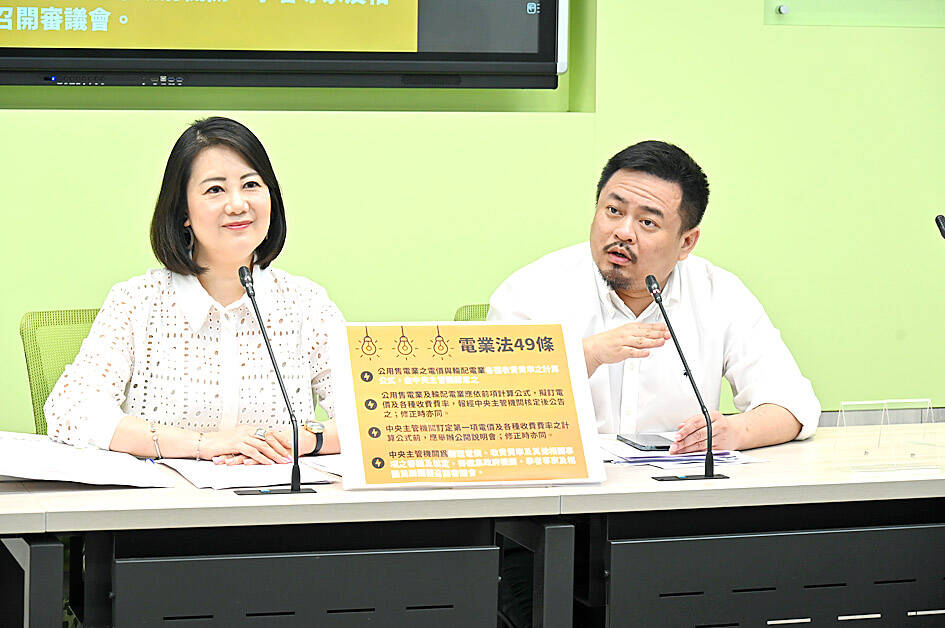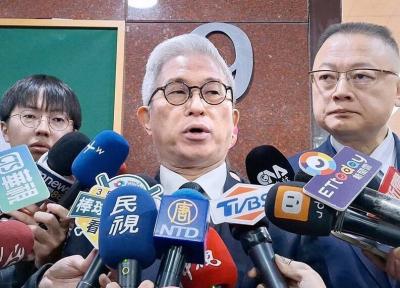National Security Bureau (NSB) Director-General Tsai Ming-yen (蔡明彥) yesterday told lawmakers that Taiwan must harden its undersea cables, but refrained from accusing Beijing of sabotaging the lines.
Tsai made the remarks during a meeting of the legislature’s Foreign Affairs and National Defense Committee in Taipei after Democratic Progressive Party Legislator Hung Sun-han (洪申翰) asked the NSB head whether the cutting of the cables linking Taiwan proper to Lienchiang County (Matsu), which occurred multiple times last year, were accidents or acts of sabotage.
Several Washington-based think tanks have suggested that Beijing might have deliberately targeted the cables, as the damaged lines were in shallow depths of 30m to 100m, Hung said.

Photo: Chien-jung, Taipei Times
The cables were on the main belt of China’s “gray zone” activities, making the case for sabotage more likely, he said.
The Ministry of Digital Affairs did not include the cables in its list of critical infrastructure, he said, adding that items on the list are to undergo regular threat evaluations and defensive drills, and be protected by robust alert systems.
Hung then asked Tsai if the NSB was taking steps to protect the undersea cables.
Although the lines were cut 20 times last year, an unusually high number of incidents, the bureau is not prepared to declare the episodes malicious actions, as intentionality could not be proven without a thorough analysis of ship movements in the area during the events, Tsai said.
Taiwan operates 14 international undersea cables linking the nation to the world and 10 cables to its outlying islands, he said, adding that the Ministry of Digital Affairs is focused on bolstering the resilience of the former.
Nevertheless, the cables to Matsu remain crucial to national security despite their exclusion from the list, he said.
Separately, the NSB submitted to legislators a report detailing the bureau’s efforts to harden national infrastructure against attacks.
Citing the National Intelligence Service Act (國家情報工作法), the report said that the NSB is empowered to preside over agencies involved in securing important sites, including the Ministry of Justice Investigation Bureau, the National Police Agency and Military Police Command.
The agencies are to send regular reports to the Executive Yuan’s Office of Homeland Security and maintain communication on matters concerning infrastructure security, it said.
A planned NSB task force would advise the office on risks, threats and weaknesses, it said, adding that natural disasters, human-caused hazards and cyberattacks are the main types of dangers to infrastructure.
Dual redundancy, frequent inspections, thorough background checks on personnel, security incident response exercises, and the full use of public and private resources are among the measures that would mitigate dangers, the report said.
Mitigation requires good data security and information-sharing practices, and the monitoring of emergent threats and security trends, it said.
The Executive Yuan began introducing dual redundancy to key oil, water, electricity and telecommunications infrastructure following a malfunction at Kaohsiung’s Hsinta Power Plant (興達電廠) in 2022 that triggered a nationwide power outage, it said.
A critical infrastructure security inspection system created last year would be implemented on 40 select sites, starting this year, it said.
Ministry of Justice Investigation Bureau would be tasked with convening a national-level conference on infrastructure security and enforce new security-related rules added to standard public construction contract templates, the NSB said.
The Executive Yuan is to hold annual Chin Hwa exercises (金華演習) to train personnel involved with the operation of critical infrastructure in responding to contingencies to boost resiliency, it said.
The Office of Homeland Security would this year conduct security incident response exercises at 20 sites, the NSB said, adding that national security officials would observe drills and exercises.

Taiwan is to commence mass production of the Tien Kung (天弓, “Sky Bow”) III, IV and V missiles by the second quarter of this year if the legislature approves the government’s NT$1.25 trillion (US$39.78 billion) special defense budget, an official said yesterday. Commenting on condition of anonymity, a defense official with knowledge of the matter said that the advanced systems are expected to provide crucial capabilities against ballistic and cruise missiles for the proposed “T-Dome,” an advanced, multi-layered air defense network. The Tien Kung III is an air defense missile with a maximum interception altitude of 35km. The Tien Kung IV and V

The disruption of 941 flights in and out of Taiwan due to China’s large-scale military exercises was no accident, but rather the result of a “quasi-blockade” used to simulate creating the air and sea routes needed for an amphibious landing, a military expert said. The disruptions occurred on Tuesday and lasted about 10 hours as China conducted live-fire drills in the Taiwan Strait. The Civil Aviation Administration (CAA) said the exercises affected 857 international flights and 84 domestic flights, affecting more than 100,000 travelers. Su Tzu-yun (蘇紫雲), a research fellow at the government-sponsored Institute for National Defense and Security Research, said the air

A strong continental cold air mass is to bring pollutants to Taiwan from tomorrow, the Ministry of Environment said today, as it issued an “orange” air quality alert for most of the country. All of Taiwan except for Hualien and Taitung counties is to be under an “orange” air quality alert tomorrow, indicating air quality that is unhealthy for sensitive groups. In China, areas from Shandong to Shanghai have been enveloped in haze since Saturday, the ministry said in a news release. Yesterday, hourly concentrations of PM2.5 in these areas ranged from 65 to 160 micrograms per cubic meter (mg/m³), and pollutants were

Taiwan’s armed forces have established response protocols for a wide range of sudden contingencies, including the “Wan Chun Plan” to protect the head of state, the Ministry of Defense (MND) said today. After US President Donald Trump on Saturday launched a series of airstrikes in Venezuela and kidnapped Venezuelan President Nicolas Maduro, concerns have been raised as to whether China would launch a similar “decapitation strike” on Taiwan. The armed forces regularly coordinate with relevant agencies and practice drills to ensure preparedness for a wide range of scenarios, Vice Minister of National Defense Hsu Szu-chien (徐斯儉) told reporters before a